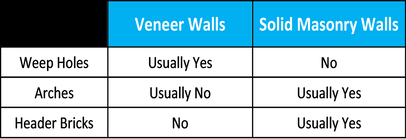Mike's Home Inspector BlogMichael Burfitt |
|
Different areas of North America tend to favor one specific type of house siding and Nova Scotia is no exception. In this week’s blog post, we look at some of the most common types of siding seen in our province. Vinyl Siding This is the most popular choice in North America (about 1/3 of all installations) and is the overwhelming choice for homes in Nova Scotia. It has largely replaced wood and metal siding due to its combination of value, durability and lack of required maintenance. Not only does vinyl siding not need to be painted, but the colour goes all the way through the material and doesn't just cover the surface, meaning a scratch or other minor damage will not affect its appearance. Home inspectors look at several concerns such as signs of waviness, joints not staggered properly (a clear sign of poor or amateur installation) and proper detailing around windows, doors, and other penetrations. While relatively easy to install, it still takes skill to do properly. It has recently come to my attention that in my subdivision, the installation techniques were far from high quality, a fact I can personally attest to that when in 2018 we lost a significant amount of siding. These deficiencies can be hard to detect during a standard home inspection. Masonry (Brick, Stone & Concrete) I have previously covered this type of siding in a previous blog post. Inspectors look for signs of spalling, mortar deterioration and bowing walls (more common in older installations). In my experience these are usually quality installations by skilled masons and are generally well maintained. Wood Shingles and Shakes Most wood siding is composed of cedar due to its rot resistance. Other species of wood can be used (such as pine) but it requires additional preservatives to protect against rot. Wood siding also requires regular maintenance (such as painting or staining) and has little in the way of fire resistance. There are many different types of wood siding installation:
Asbestos Cement/Fiber-Cement Asbestos is a scary word and as a result asbestos cement siding has received an unfair bad reputation. As can be seen on my previous posts on asbestos, it is only dangerous in a friable state. Translation: there is no danger if the siding is not disturbed by heavy mechanical damage. Overall, it is a good siding material but since it was discontinued many years ago properly repairing it may be difficult, if not impossible. Modern versions of fiber-cement are commonly known by its main trade name Hardie board. It has many of the advantages of asbestos siding without the…. you know…. asbestos. It can be very hard to tell apart from wood and possibly my single biggest goof up as a home inspector was mistaking Hardie board for wood siding. It was located only in a specific area of the home on the second level and it taught me to always verify my visual observations by touch as much as humanly possible. Stucco/EIFS
Even though these two systems look identical, they are quite different. They are also common…. in commercial settings. Despite being very common on homes in other areas of North America, they are very rarely seen on houses in Nova Scotia. I actually had to do some research on these two types of siding and why they aren't more common, to which I will share my findings in next week’s blog. We are all familiar with the story of the Three Little Pigs: the big bad wolf destroyed the straw and stick houses with ease but could not blow down the brick house no matter how much he huffed and puffed. In short, brick is a solid construction material commonly used in chimneys due to its heavy fire resistance although it is not without its drawbacks. The structure of most modern brick houses is not actually made of brick. Yes, the outer walls are constructed with real bricks and are built by masons, but they are mainly for decorative purposes and for protecting the actual walls of the home. A veneer wall and a solid wall might seem identical on the surface but in actuality they are quite different. The biggest difference is that with solid masonry, the brick walls are supporting the house while in veneer construction, it is the opposite: the house is holding up the brick wall! Why then did veneer walls become the norm rather than solid brick? It’s easy to say $$$ but it is a little more complicated than that. As our understanding of building science has grown, we realize the importance of good insulation and what makes a good insulator (hint: something that traps air and is usually light) and brick definitely does not meet that definition. With veneer walls, we usually see a wood framed wall with insulation in the cavity. How Does an Inspector Tell Them Apart? While the obvious answer is that if brick is visible in the interior, it is a solid masonry wall but it is rarely that simple, as drywall finishes usually cover the exterior walls. There are three main differences as outlined below: So….. Which Is Better?
Once again, the answer is “it depends”. Solid brick walls are …. drum roll please…. solid and strong while a veneer wall, while still strong provides plenty of space to add insulation. Some might point to the heavy fire resistance as a big plus to brick but that isn’t really a major consideration: most fires start on the inside of the home and any major fire will likely result in a total loss to the home. As with nearly every feature in a home, each has its advantages and disadvantages with much of the decision coming down to personal preference. |
Archives
July 2024
Categories
All
|
|
Inside Edge Home Inspections Ltd.
Halifax, NS 902-209-9921 [email protected] Proudly Serving the HRM & Central Nova Scotia |




 RSS Feed
RSS Feed

